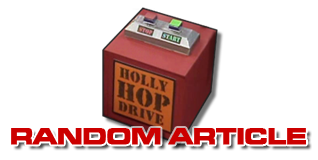Second Time Lucky
With its second series, Red Dwarf developed its style into the shape we now take for granted.
21 March, 2003
The second series is a tricky beast. No matter whether your series one was a runaway hit or a shaky start, series two is the one that cements a show's reputation.

It's no secret that Rob Grant and Doug Naylor felt that Red Dwarf I (as it was later re-christened) did not reflect the best that could be achieved. The sets were grey - really grey - and the cast weren't gelling with the material as well as they might.
Rob and Doug had cast two performers on the basis of their chemistry - the spark between Chris Barrie and Craig Charles was palpable. But Lister was written to be in his 40s, a whacked-out space bum with a fried brain - a kind of intergalactic Johnny Vegas.
Series II gave the writers a chance to re-establish their characters. Lister's relationship to lager and curry is actually established in this series, not in the first, and was based on the way Craig was perceived by audiences. Out with the fried brain and in with the Scouse rogue.

Likewise, Rimmer was altered to play on Chris Barrie's strengths. Rimmer's entire personality in Series I was based on sketch-show characterisation - an antagonist with no particular motivation. In Series II, Rimmer was given a history, a past. A psychotic father, three over-achieving brothers - the seeds to Rimmer's self-loathing are sown right here.
Similarly, Lister's heritage is established. Craig's Lister had taken on his 'last human' status with more nobility than was written, and so his past became more fitting. Lister was an abandoned baby, raised by adoptive parents never knowing who he really was. Becoming the last surviving human seemed to give him purpose and direction.
Proof of these changes can be found in the continuity tweaks. In Series I Rimmer mentions his father in terms of "that unfortunate suicide business". The implication - handily refutable now - is that Rimmer's dad topped himself. But instead, the Rimmer that developed was one tortured by his military-obsessed father.

Similarly, Lister's history includes a rather manly grandmother and a father who owned a dog named Hannah. Again, these have been retro-fit into the continuity by suggesting that this is his adoptive family. In fact, Lister's 'birth' in a cardboard box under a pool table would not be included in the show until Series III, though it was in place for the first novel, Infinity Welcomes Careful Drivers, which followed Series II.
Just as Holly was created to be a 'straight man' (and a voice-over to boot) but altered to suit Norman Lovett's talents, so every Red Dwarf character has become a composite of written concept and performer. Which brings us rather neatly to the first episode of Series II and its title character - Kryten.
Created as a one-off character, Kryten would eventually be added to the main line-up full-time. David Ross was chosen to reprise his role, but was unavailable.

Consider for a moment how different Kryten might have been. Both incarnations are cursed by their programming to serve, to live a life of slavery. Both also have the ability to rebel. So far, so similar. But where David Ross's incarnation was tinged with sadness, Robert Llewellyn's Kryten seemed more filled with... joy.
Robert's Kryten enjoys ironing. There's no tragedy to his existence - he takes pleasure in the tasks he is given. It will come as no surprise that Robert's own personality has become integrated with the character; Robert likes doing the washing up.
Series II of Red Dwarf shows a greater confidence with its characters. The dialogue sizzles, and thanks to that the stories seem effortless. The truly amazing thing is that Series I was reassessed as a result. Fans who got to know the characters over the subsequent series looked back at the first season and enjoyed it all the more because they were looking at characters they had already got to know.
Kryten was Red Dwarf's first mechanical character, talking computers and toaster aside. Eventually this would evolve into stories involving Hudzen 10, simulants, Diva Droid International and the human-looking 3000 Series.
Also introduced in Kryten is Blue Midget. Finally the crew get to leave the confines of Red Dwarf and explore new spaces. In a few series' time, both the Midget and Red Dwarf itself would be superseded by Starbug - but it all started right here.
But it is Better Than Life that perhaps best captures the flavour of what Dwarf was to become. In later series, the use of alternate states of reality would become a feature - either by technological choice (Gunmen of the Apocalypse, Beyond a Joke) or without the character's knowledge (Back to Reality) or both (Back in the Red).

Thanks for the Memory - where Lister gifts Rimmer three months of his memory as a present - is a rare type of show, in that its themes have yet to be echoed. Crew members have swapped bodies, but memories have since remained in place. Lister forgets who he is in Psirens, but that's about it.
More common is the fact that the Dwarfers are the cause of their own problem - a theme that would come back constantly. Not least in Tikka to Ride, the recent time-travel episode where Kryten's lack of ability with the Time Drive drops the crew 200 years from their planned destination. Series II, of course, also contains the first full Red Dwarf time travel story - Stasis Leak.
Queeg seems to come from the idea begun in Me2 that Holly is something of a practical joker. Its famous ending - where Queeg is revealed to be Holly's "jape of the decade" - has similarities to the ends of Marooned (where five black holes turn out to be grit on the scannerscope) and Duct Soup (where the locked doors and electrical failure are actually caused by a jealous Kryten).

Before that ending, though, is another Red Dwarf theme. Holly is replaced by a more impressive, more capable successor. The following year, Kryten would face a similar problem in The Last Day, as Hudzen 10 arrives to take his place. And don't forget the crew auditioning new ship's holograms to replace Rimmer in Holoship, or Rimmer's reaction to Ace in Dimension Jump. All the Dwarfers live with a basic fear that someone else could do what they do, only better.
The final episode of Series II is Parallel Universe, the third episode in what would become a long line of 'alternate personality' stories. Following on (in part) from Future Echoes, and to a greater extent from Me2, later stories that used similar ideas would include Dimension Jump (again), Demons and Angels, Out of Time and Ouroboros.
In almost every instance, the alternate versions really gave us a perspective on the characters we knew. Their fears, their weaknesses, as well as their strengths and abilities. In the case of Parallel Universe, Rimmer's sexual politics are thrown into horrifying perspective when the roles are reversed by his equally-sexist female counterpart.

Sure the walls were still grey (save for the additional set decoration), and the costumes weren't as dynamic as they would become. Sure, Kryten's make-up and character were both in need of an upgrade. But Series II is the series that locked Red Dwarf down, that blended the comedy and science fiction just right, that made the characters three-dimensional.
It's the series that made everything else possible.














